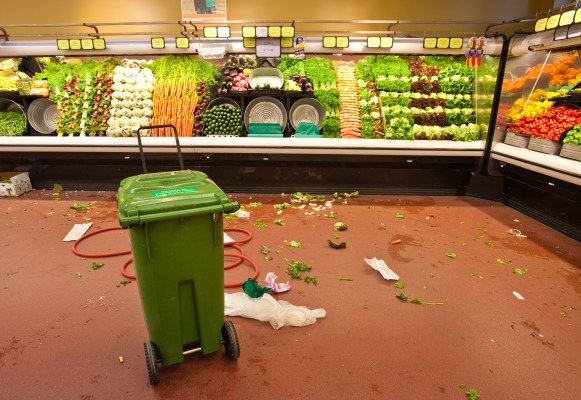Every year, about 35% of the food supply in the U.S. is wasted. About half of that’s because of picky eaters or outsize restaurant portions, but the rest happens further upstream, according to the U.S. Environmental Protection Agency, with about 6% to 13% occurring at grocery stores.
For grocery stores, which operate on very thin margins, that loss is significant. The environmental toll is big, too: Grocery store and other retail food losses in the U.S. alone represent 10 million to 20 million metric tons of carbon pollution annually. That’s about as much as some entire countries, like Kenya or Guatemala.
A large part of food waste’s carbon problem happens at the landfill. There, microbes break the food down anaerobically, meaning without oxygen. That process releases methane, a greenhouse gas that’s 84 times more potent than carbon dioxide over 20 years. Landfills can capture the methane and burn it, using it to produce power, for example.
Burning the methane transforms it into carbon dioxide and some other pollutants. While the pollution burden isn’t ideal, from a climate perspective, it’s probably better than the alternative. Only about a fifth of all U.S. landfills capture the gas; the rest just let it seep into the atmosphere.
Part of the problem with landfill gas is that it can be hard to capture. If you’ve ever seen a landfill, you probably understand why. They’re not exactly precision machines.
Intercepting food waste before it hits the landfill changes the equation, though. That’s where Divert hopes to step in.
The company, which was founded in 2007, works with grocery store chains like Ahold Delhaize, Albertsons, Kroger, Safeway and Target to tackle the problem. It starts by analyzing a store’s waste stream and suggesting ways to minimize waste in the first place.
In stores, some food is tossed because it’s past its “best by” date. That doesn’t always mean what people think; the food is frequently edible. Other times produce gets thrown out because it doesn’t look quite right. Still other produce really has gone bad and should be tossed.
Every store has a process for dealing with food that falls into the various categories, but in the end, it often winds up in the same place — the dumpster.
For items that are still good but maybe past their “best by” date, Divert finds ways to donate them. Lastly, for food that can’t be rescued — think wilted spinach or moldy strawberries — Divert sends it to an anaerobic digester, a big machine that replicates what happens in a landfill in a much quicker, more controlled fashion.
Divert was, for many years, a very lean operation. The company raised just over $5 million in the first 14 years, co-founder and CEO Ryan Begin told TechCrunch. Its long gestation time ended up being a feature, not a bug, because it allowed the company to hone its business model into something quite sharp. Over time, its focus expanded from anaerobic digesters to include reducing food waste overall.
That helped it form partnerships with large chains like Krogers and Ahold, which owns Stop & Shop and Hannaford, among others. In 2021, when the rest of the world was going crazy with SPACs, the company was acquired for $100 million in growth equity by Ara Partners, along with GIC and Ontario Power Generation.
“That accelerated development on three different projects that we have across the country, accelerated our technology group as well,” Begin said.
Now, Begin said the company has secured another $20 million from Ara Partners and $80 million from Enbridge, the Canada-based oil and gas pipeline company. Enbridge is also providing $1 billion in structured finance so the company can build a nationwide network of anaerobic digesters to turn food waste into easily captured biogas. The goal is to build enough of the facilities to cover 80% of the population of the U.S.
Many biogas operations burn the fuel on-site, producing heat or electricity or both. In a combined heat and power setup (also known as cogeneration), about 65% to 80% of the energy locked in the biogas is recovered, according to the EPA.
Begin argues there’s a better option. “If you look at the energy efficiency, you look at the lifecycle analysis, better to put that into a pipeline. We can then heat homes, because now you’re into the high 90% efficiency [range],” he said, referencing the efficiency of a typical residential gas-fired furnace.
While that setup makes the most use of the biogas’ energy, it’s certain to rankle some in the climate tech community, who argue that it’s better to phase out gas infrastructure entirely. That’s in part because there’s not enough biogas to support today’s sprawling natural gas infrastructure. The U.S. uses about 30 trillion cubic feet of natural gas every year, while the Department of Energy estimates that biogas could supply about 0.42 trillion cubic feet of methane annually, just over 1% of today’s demand.
Regardless, while biogas is an integral part of Divert’s business model, the waste reduction side has grown to be quite large. “We’re donating 85% of what was going to the landfill,” Begin said. That means just 15% of what stores throw out ends up heading for the digesters. “When we look at responsible infrastructure, reducing wasted food is by far the most important thing we can do. All of our contracts are structured that way.”
If Divert is able to follow through on its expansion plans, it says it’ll offset nearly 400,000 tons of carbon pollution. That’s pretty significant, no matter what happens to the biogas.
